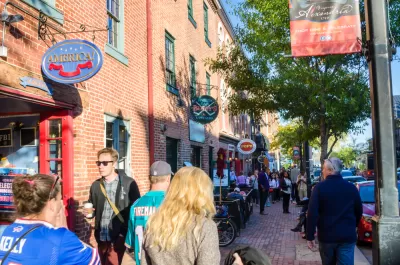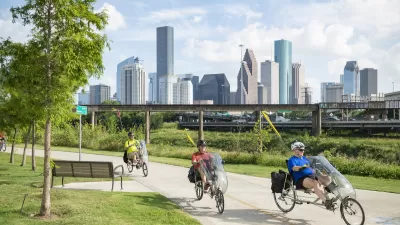When mixed-use development isn’t enough to create vibrant, walkable neighborhoods.

Urbanists make a lot of hay of ‘mixed use,’ writes Erin Caldwell in an op-ed for Next City. Neighborhoods need diverse businesses and services to thrive, urbanists frequently say. But what about the types of businesses?
According to Caldwell, “A neighborhood dense with businesses that do not meet the weekly needs of residents is no better than a neighborhood absent businesses with respect to walkability. Walkability depends, at least in part, on having comprehensive retail.”
For Caldwell, this offers an opportunity for cities to guide development through their zoning codes. “How can cities encourage the presence of businesses that satisfy daily necessities? While zoning based on business type is not new, traditional zoning does not take business usefulness into account. But what if zoning laws allowed useful businesses in residential or mixed-use areas and relegated non-useful businesses to industrial or commercial districts?”
Usefulness is, of course, subjective, so this type of code may be difficult to create and enforce. Caldwell suggests creating objective measures such as the number of in-person transactions or amenities such as public restrooms, bike racks, or public seating. “Besides re-zoning, enrichment through mixed-use can be achieved by permitting business spaces attached to residential units, commonly known as accessory commercial units.”
For Caldwell, retail can have a major impact on community. “Accessible retail and recreation centers are akin to ‘town squares’ in that they provide places and reasons for neighbors to congregate. Repeat visits to businesses increase the likelihood of interaction between neighbors, as well as business staff, who also form an integral part of the community.”
FULL STORY: For Walkable Neighborhoods, We Need More Useful Businesses

Study: Maui’s Plan to Convert Vacation Rentals to Long-Term Housing Could Cause Nearly $1 Billion Economic Loss
The plan would reduce visitor accommodation by 25,% resulting in 1,900 jobs lost.

North Texas Transit Leaders Tout Benefits of TOD for Growing Region
At a summit focused on transit-oriented development, policymakers discussed how North Texas’ expanded light rail system can serve as a tool for economic growth.

Why Should We Subsidize Public Transportation?
Many public transit agencies face financial stress due to rising costs, declining fare revenue, and declining subsidies. Transit advocates must provide a strong business case for increasing public transit funding.

How Community Science Connects People, Parks, and Biodiversity
Community science engages people of all backgrounds in documenting local biodiversity, strengthening connections to nature, and contributing to global efforts like the City Nature Challenge to build a more inclusive and resilient future.

Alabama: Trump Terminates Settlements for Black Communities Harmed By Raw Sewage
Trump deemed the landmark civil rights agreement “illegal DEI and environmental justice policy.”

Dear Tesla Driver: “It’s not You, It’s Him.”
Amidst a booming bumper sticker industry, one writer offers solace to those asking, “Does this car make me look fascist?”
Urban Design for Planners 1: Software Tools
This six-course series explores essential urban design concepts using open source software and equips planners with the tools they need to participate fully in the urban design process.
Planning for Universal Design
Learn the tools for implementing Universal Design in planning regulations.
City of Santa Clarita
Ascent Environmental
Institute for Housing and Urban Development Studies (IHS)
City of Grandview
Harvard GSD Executive Education
Toledo-Lucas County Plan Commissions
Salt Lake City
NYU Wagner Graduate School of Public Service





























